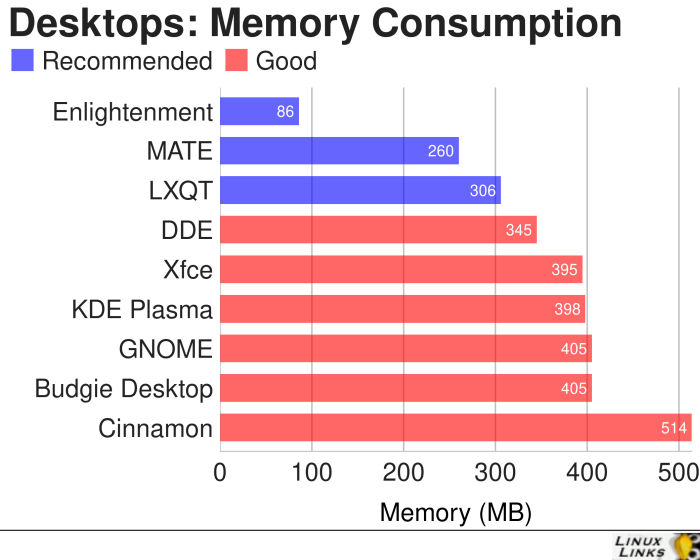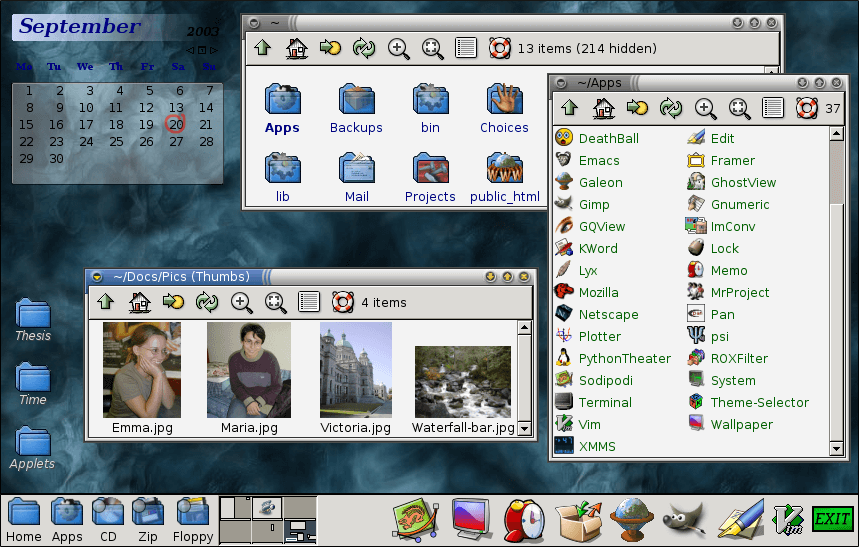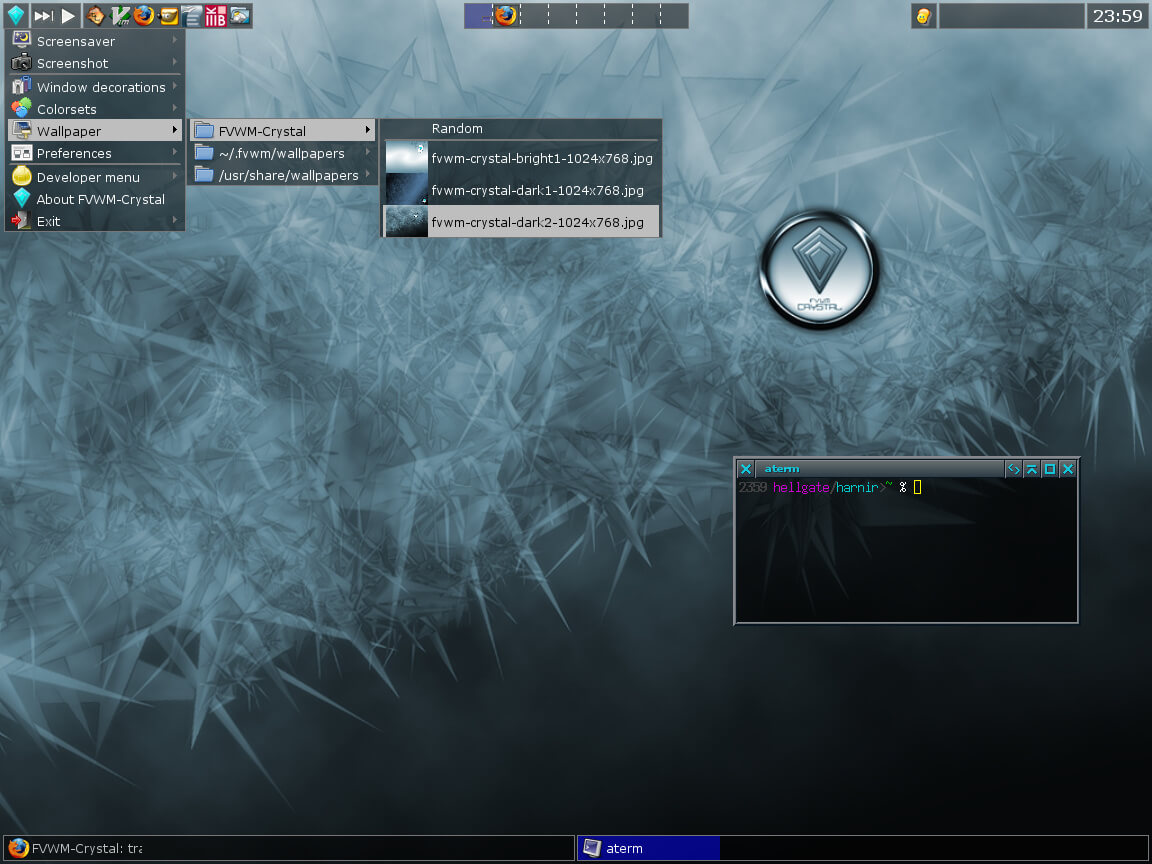Back in early 2008, we published a feature recommending the best 6 lean desktop environments. These desktops are: Xfce, ROX Desktop, LXDE, FVWM-Crystal, EDE, and Étoilé.
How did these desktop environments fare over the past 12 years? Are they still going strong, are they outclassed by other software, or are they only remembered like fingerprints on an abandoned handrail?
Let’s start with Xfce.
Xfce
Xfce aims to be fast and lightweight while still being visually appealing and easy to use. It aims to be fast and low on system resources.

We were impressed with Xfce in 2008. And we’re still impressed by this desktop environment. The project has migrated to GTK3, witnessed a big revamp of its user interface, and more besides. It fared particularly strong in our recent survey of the best desktop environments. The project is under active development.
While the project bills itself as a lightweight desktop environment, this advantage has diminished. As the chart shows, its memory footprint is about the same as KDE and GNOME. That’s not really the fault of Xfce, it’s more a reflection that GNOME and KDE’s recent releases have made good strides in reducing memory consumption.
ROX Desktop

ROX Desktop was started by a University of Southampton student back in 1999.
The ROX desktop is no longer being actively developed, but its legacy still lives on. When the project was active, it stood out from the crowd, offering a different approach.
ROX is mostly abandoned and left in fragments that the user is left to sort out.
LXDE
LXDE (Lightweight X11 Desktop Environment) was built to be lightweight, user friendly, and fast. The software seeks to be modular, so each component can be used independently.
LXDE is present in the Community repository for Arch. The pace is development is glacial though.
A spinoff from LXDE is LXQt which was formed from the merger of LXDE and Razor-qt. LXDE and LXQt coexist as separate projects, but their goals are identical: to provide a lightweight desktop.
FVWM-Crystal

FVWM-Crystal aims to create an easy to use, powerful desktop environment. It’s based around the FVWM window manager. Unlike many other lightweight environments available at the time (in 2008), it also featured plenty of eye-candy. FVWM-Crystal boils down to a set of FVWM configuration files, some Python and shell scripts, a set of application icons and images.
FVWM-Crystal receives very little press. But it’s still under active development with regular releases. It supports about 400 different applications, with advanced support for terminals, and great keyboard support. Recent updates include a new configurable button bars which offers a contemporary look.
EDE
EDE was billed as a small desktop environment built to be responsive, light in resource usage and to have a familiar look and feel.
The project saw a couple of major releases in 2013 and 2014. But sadly the project didn’t carry on with development. With its last update in June 2014, this project is not on its last legs, it’s as dead as a doornail.
Étoilé
Étoilé was intended to be an innovative GNUstep based desktop environment built from the ground up on highly modular and light components with project and document orientation in mind. We liked its framework and some of its applications including Mélodie, a music jukebox using CoreObject for the music library and MediaKit for playback.
Back in 2008 Étoilé was in an early stage of development and was not ready for production systems. The focus of Étoilé moved from a desktop environment to a development environment.
The software is sadly abandoned seeing its last release way back in April 2012. The GitHub repositories are still floating around but nothing builds. This project was exciting, but never fulfilled its promise.
All the articles in this series:
| Now and Then - See How Promising Open Source Software Has Fared | |
|---|---|
| DFileManager | A venerable file manager |
| More Distributions | The fate of 15 more distributions |
| Programming Languages | Go, Rust, Dart, Julia, Clojure, Elixir and more |
| File Managers | SpaceFM, gentoo, Marlin, Eagle Mode, and Beesoft Commander |
| Distributions | The fate of 15 distributions |
| Lean Desktop Environments | Xfce, ROX Desktop, LXDE, FVWM-Crystal, EDE, and Étoilé |
| IDEs | Brackets, Light Table, Julia Studio, Dart Editor, and Aptana Studio |
| Music Players | qomp, Lollypop, Yarock, Pragha, and Volumio |
| Web Browsers | eww, Liri, Vivaldi, Ubuntu Internet Browser, Fifth, Dooscape, and Breach |
| Terminal Emulators | Terminology, Cool-Retro-Term, and Final Term |

ROX-Filer is alive and actively developed. In combination with JWM windrow manager, it is the desktop on Puppy Linux and derivatives such as EasyOS.
What’s your point Barry? The ROX desktop is no longer being actively developed as evidenced from the project’s website. It was a collection of applications, one of which was ROX-Filer. A few bits of it may live on (forked by others) etc. That doesn’t mean the project is alive.
The last official release of ROX-Filer was in 2011. It’s probably in some distro’s repositories (it is in Arch). Even if it has been forked, a file manager combined with an independent window manager does not make a desktop environment.
Whatever happened to rat poison?
Ratpoison is a tiling window manager, not a desktop environment. Ratpoison saw its last stable release in 2017. It features in our roundup on the best tiling window managers.
Not sure why Cinnamon shows, on your chart to be the most resource heavy. On my laptop it appears to be the same as The Wife’s Mate DE. (Both using HP Pavilion.) Just curious.
How are you measuring?